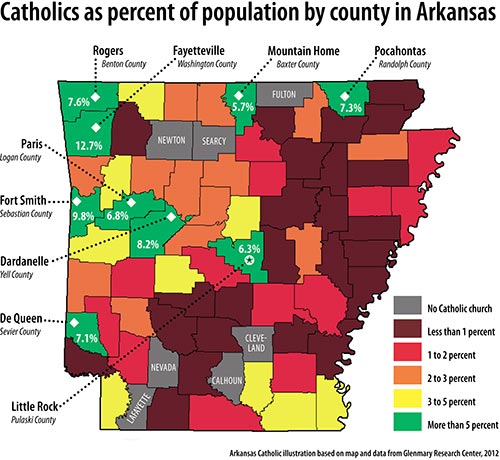The Catholic Church is the fourth largest religious body in Arkansas, according to the recently released Religious Congregations and Membership Study.
According to the study, released May 1 and based on 2010 statistics, there are 122,662 Catholic parishioners in the state in 126 congregations. The Catholic Church trails only the Southern Baptist Convention (661,382 adherents), the United Methodist Church (158,574 adherents), and independent, non-denominational churches (129,638 adherents).
Click here |
"Catholics tend to be more prevalent in the northern and western counties of the state," said Clifford Grammich, a research associate with the Glenmary Research Center.

The Glenmary Research Center is the research arm of Glenmary Home Missioners, which is dedicated to bringing a Catholic Church presence to counties throughout the South and Appalachia. The center contributed the county-level enumeration of Catholic congregations and adherents to the census, as it had previously done for similar studies in 1971, 1980, 1990 and 2000.
"Catholics are more than 5 percent of the population in nine counties." Grammich added. "There are also more than 12,000 Catholics in each of four counties: Washington, Benton and Sebastian, each on the western border of the state, and Pulaski, home to Little Rock, the most populous city in the state."
A higher percentage of Catholics are also living in Logan and Yell counties in western Arkansas, Sevier in southwest Arkansas and Randolph and Baxter counties in northeast Arkansas.
As metropolitan areas, it is expected that Pulaski (Little Rock, North Little Rock), Benton (Rogers), Washington (Fayetteville, Springdale) and Sebastian (Fort Smith) counties would be on the list.
The other counties might not be expected. Logan County is the location of eight Catholic churches in addition to Subiaco Abbey. Catholic churches are located in Morrison Bluff, Scranton, Paris, Ratcliff, Prairie View and New Blaine, Booneville and Subiaco.
Yell (Dardanelle, Danville) and Sevier (DeQueen) counties are high on the list because of their large numbers of Hispanics. Randolph County, with churches in Pocahontas and Engelberg, has always been known for its large number of Catholics. Baxter County, with a church in Mountain Home, has a large number of retirees who moved to the state from the Midwest and North.
Grammich noted the Catholic population is even more concentrated in these counties than the total population is. While a little more than three in 10 people in Arkansas are in these four counties, more than six in 10 Catholics are. Such concentration matches that of the Catholic Church elsewhere; nationwide, only 3.3 percent of Catholics are outside metropolitan or micropolitan areas.
A strong indicator of rural mission needs in the state, Grammich said, is the seven (of 75) counties which do not have any Catholic church. They are Fulton, Searcy and Newton counties in northern Arkansas and Lafayette, Nevada, Cleveland and Calhoun counties in southern Arkansas.
Another 43 counties in the state have only one Catholic church, meaning two-thirds of Arkansas counties have no more than one Catholic church. Catholics are also less than 1 percent of the population in 31 Arkansas counties.
The census, conducted by the Association of Statisticians of American Religious Bodies, counted adherents and congregations by county for 153 religious bodies, and congregations only for an additional 83 bodies. Further information on Catholic data can be found at http://www.glenmary.org/rcms2010.
Where can you find the highest percentage of Catholics in Arkansas?
The following statistics are based on 2010 data compared to total population.
1. Washington County: 12.7 percent of residents identify themselves as Catholic. (Catholic population increased 154 percent from 2000 to 2010)
2. Sebastian County: 9.8 percent (increased 23 percent)
3. Yell County: 8.2 percent (increased 385 percent)
4. Benton County: 7.6 percent (increased 85.9 percent)
5. Randolph County: 7.3 percent (decreased 22.3 percent)
6. Sevier County: 7.1 percent (increased 7.9 percent)
7. Logan County: 6.8 percent (decreased 50 percent)
8. Pulaski County: 6.3 percent (decreased 18.6 percent)
9. Baxter County: 5.7 percent (decreased 39.6 percent)
Please read our Comments Policy before posting.
Article comments powered by Disqus 'Cabrini' film tells story of saint with great faith
'Cabrini' film tells story of saint with great faith
 Bishop Taylor announces more pastoral appointments
Bishop Taylor announces more pastoral appointments
 Most U.S. Catholics approve of Pope Francis, Pew says
Most U.S. Catholics approve of Pope Francis, Pew says
 Winning directory photo honors Our Lady of Guadalupe
Winning directory photo honors Our Lady of Guadalupe
 St. Joseph a model of solidarity with immigrants
St. Joseph a model of solidarity with immigrants
 Two gifts after Jesus’ death: Virgin Mary and Eucharist
Two gifts after Jesus’ death: Virgin Mary and Eucharist
 Why we have an altar, and not just a communion table
Why we have an altar, and not just a communion table
 Pope: Wars should be resolved through nonviolence
Pope: Wars should be resolved through nonviolence
 Living relationship with Jesus Christ in the Eucharist
Living relationship with Jesus Christ in the Eucharist